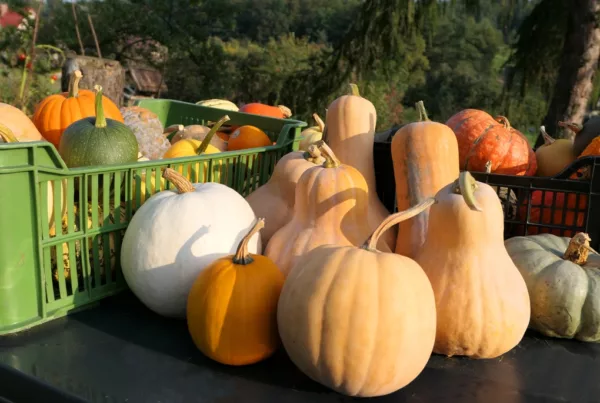Written by Kristina Hicks-Hamblin
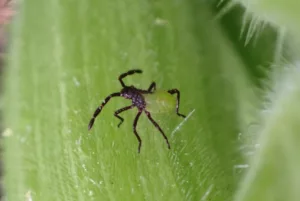
Baby squash bug on a squash plant. Photo by Chad Hamblin.
What happens when uninvited guests start harvesting your Square Foot Garden? We’re talking pest here — and while Square Foot Gardening offers pretty compelling advantages over traditional gardening methods in terms of space, time, and energy savings, there’s no way around it: when you’re growing fruits and vegetables for yourself, the local bug community would like some too.
While you definitely want the beneficial bugs to stay (think bees, butterflies, ladybugs), unwanted visitors are a different story. Here’s what to look for and how to safely control 3 of the most common ones.
Controlling Aphids in a Square Foot Garden
There are many different types of aphids, but the ones found in the raised bed garden are usually quite small and are often green, brown, orange, or black in color.
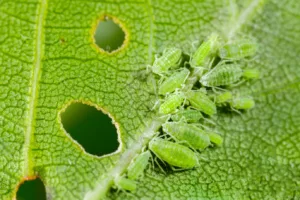
Aphids on underside of leaf.
These tiny insects tend to hide out on stems or the bottom sides of leaves, where they suck sap from plant tissues, weakening crops and sometimes spreading plant diseases.
Once you have correctly identified the bugs on your raised bed crop as aphids, your first line of approach is a fairly easy one — use a garden hose to spray a strong jet of water to wash the aphids away.
Repeat if needed a few times a day and for several days. It may sound too good to be true, but don’t knock it until you try it. You may be amazed at how well this strategy works.
A Simple Solution for Cut Worms in Your Garden Beds
Have you ever admired young seedlings emerging from the Mel’s Mix in your grid – only to be met with disappointment the next day as some of those seedlings had their tops lopped off?
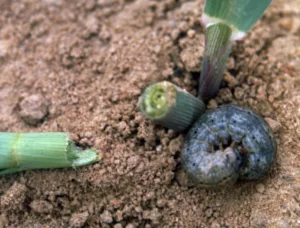
Cutworm and severed corn stalk. Photo by Frank Peairs, Wikimedia Commons, via CC BY 3.0.
Blame the cutworms. They may look like worms, but they’re actually caterpillars – the larval forms of moths.
Cutworms usually like to spend the day barely under the soil, emerging only after dark to go find their dinner. They target young seedlings with tender stems, and leave tell-tale damage behind: seedlings that look like they’ve been decapitated.
To protect emerging seedlings from cutworms, you can fashion DIY “collars” for them out of empty toilet paper rolls cut in half. Place the roll around the seedling and sink it into the soil half way. Once the seedling has matured and has a tougher stem, you can remove the protective cardboard barrier.
Eliminate Squash Bugs Immediately After Watering Your Garden
Squash bugs attack members of the gourd family. They are partial to summer and winter squash, but are sometimes found on melon and cucumber plants too. Squash bugs are brown, black, or gray, and look a bit like stink bugs but are slightly narrower and longer. Frequent inspecting and hand picking is the best way to protect plants from squash bugs, and the best time to check for them is right after watering.
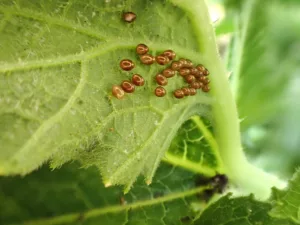
Squash bug eggs on underside of squash leaf. Photo by Kristina Hicks-Hamblin.
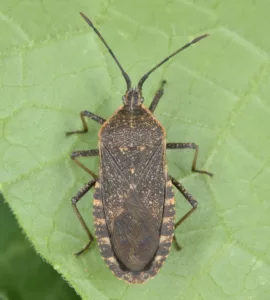
Squash bug. Photo by Christina Butler, Wikimedia Commons, via CC BY 2.0.
These pests tend to hang out in the crown of the plant and will scurry away when water reaches them, which makes the perfect time to nab them immediately after watering making. Be forewarned, squash bugs emit an unpleasant smell when crushed.
Be sure to also look for the eggs of squash bugs on the undersides of leaves — they can be orange, brown or black. Remove and destroy them too. You may also find freshly hatched squash bug babies feeding near the crown of the plant, and these should also be dispatched.
Seek Help from Natural Predators in Your Garden
While each of these pests can be dealt with in the ways described above, it’s also important to tilt the odds in your favor by cultivating a healthy garden eco-system. That means using companion plants, rotating crops, and above all, enlisting the help of natural pest predators.
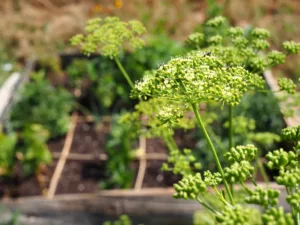
Parsley flowers attract beneficial insects to the raised bed garden. Photo by Kristina Hicks-Hamblin.
Beneficial insects, including ladybugs, lacewings, and parasitoid wasps, can help you keep the undesirable pest populations controlled in your garden beds. Invite them in b y including some of their favorite nectar and habitat plants in your Square Foot Garden. Herbs like parsley, dill, and cilantro, and flowers like zinnias, and cosmos can make the beneficial insects and you happy too.
When inspecting raised bed plants, watch for aphids that are bloated and opaque, which is a sign that wasps have parasitized them, which is great news! It’s a key indicator that you have predator bugs working on your side. There are even parasitic wasps and flies that target squash bugs.
Birds can also be enlisted for pest control. To keep cutworm populations in check, place bird houses nearby. In spring time, robins and other songbirds hunt for tender larvae like cutworms to feed their babies. If you see a cutworm in your Mel’s Mix, toss it out of the raised bed to a spot where a bird will easily find it.
BTW, there are more than just 3 pests to watch for in your Square Foot Garden, but with any pest, take this straightforward approach: identify the bug, remove it if it’s causing damage, and work on attracting natural predators.
Should You Use Organic Spray Pesticides in a Square Foot Garden?
Square Foot Gardening is an organic approach to growing food, so even certified organic sprays should be a last resort when dealing with unwanted insects, since these products can harm beneficials as well as pests. Whenever possible, stick with the solutions described above.



